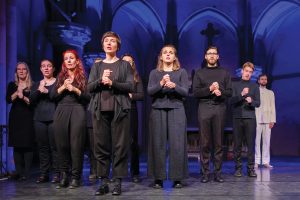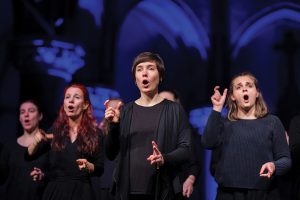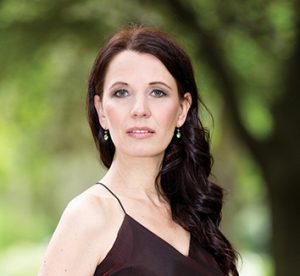Susanne Haupt, singer, Germany
SING&SIGN described in one sentence
The non-profit Leipzig-based association SING&SIGN and its inclusive ensemble, consisting of professional and semi-professional musicians, both hearing as well as hearing-impaired and multiply disabled, make vocal works particularly by J.S. Bach accessible to the sign language community by making music using sign language.
Intention
Bach’s music, an essential part of German culture, is almost inaccessible to hearing-impaired performers or concertgoers. The idea of participation is often still lacking, especially in the field of classical music. Johann Sebastian Bach said:
“All music should glorify God and delight people”. To do justice to this statement, to delight all people and exclude no one, one of the intentions of this project is to combine classical sacred music culture with sign language culture, which are usually found side-by-side rather than together.
Ensemble
The ensemble was founded in 2017 by the soprano Susanne Haupt and is under the patronage of the retired Thomaskantor Prof. Gotthold Schwarz, the director of the Leipzig Bach Festival Prof. Dr. Michael Maul and the director of the CI (Cochlear Implant) Centre, University Hospital Leipzig Prof. Dr. Michael Fuchs.
It now consists of about 50 hearing-impaired, multiply disabled and hearing participants, predominantly young adults, and brings together several groups:
-
- The professional musicians of the ensemble are renowned freelance vocal soloists and instrumentalists who form a baroque ensemble.
- The signing choir consists of semi-professional vocalists and people with various disabilities such as a hearing impairment, visual impairment, Tourette syndrome, APD (auditory processing disorder) or learning disability, autism, physical disability.

Regional and national
The city of Leipzig is famous for music and Bach. In addition to weekly Bach cantatas by the Thomaner Choir, around 30 Bach Christmas oratorios and Passions are prepared and performed there each year. By hearing people for hearing people and therefore not accessible to those with disabilities. In order to offer the largely ignored hearing-impaired audience regular participation in this tradition, the ensemble offers an audio-visual, sometimes interactive and staged, accessible performance of these works during the liturgical year: cantatas of the Christmas Oratorio in the Advent season and St. John Passion in the Passion season, with selected cantatas or motets inbetween and a hands-on children’s concert. The St. John Passion had its premiere in April of this year. From December 2023 onwards, there is a plan to perform an accessible-to-all cantata from the Christmas Oratorio every year in cooperation with the Tabor community until all six cantatas have been completed. The aim is for these concerts to have a permanent place in the concert calendars in and around Leipzig. The sign language community is supported with part of the concert revenue. This makes Leipzig the first city in Germany to regularly perform accessible Bach works with this pilot project. Having said that, this innovative, hitherto unique project will be introduced in other cities to reach the hearing-impaired in other places. This will happen partly in collaboration with other ensembles and institutions in order to reach out to as many people as possible with the theme of inclusion and to drive this idea forwards.

Inclusion needs culture – Culture needs inclusion
Hearing people learning German Sign Language (DGS) and the involvement of the hearing-impaired in musical performance is a step towards a smaller but special cultural community. Mainstream society should not expect, just because it is greater in numbers, other linguistic and cultural communities to understand their language and fully adapt to it.
The usual practice for interpreters or hearing-impaired individuals to sign next to and not with the musicians is, for example, an image of separation and not of unity for the ensemble. This is because the hearing and hearing-impaired mostly communicate only among themselves. It is for this reason that the hearing singers of the ensemble communicate directly with the deaf community in the area of music with the help of signs, out of respect for this culture, even if they are sign language beginners. The music becomes visible and tangible and thus gives something back to those from whom they are learning the language. The hearing-impaired also sign the music together with the hearing and thereby gain insights into the world of music. This allows an exchange to flow between the cultures, from which both sides benefit.
In addition to the texts of the musical works, the hearing participants learn the basics of sign language so that they can exchange ideas with the hearing-impaired and form a community.

Insight into the process
First, the biblical texts are translated and written into DGS in collaboration with hearing-impaired individuals, theologians and sign-language interpreters. They are then visualised via video as a learning aid for the singers. Since sign language differs from the grammar of the spoken language in terms of sentence structure and placement, there are two translations. One in DGS for the hearing-impaired and one in near-DGS for the hearing singers. In weekly ensemble rehearsals, all the singers learn signs and music by heart: the hearing sing the vocal music and sign near-DGS under direction, the hearing-impaired sign in DGS in the metre of music, alongside the hearing, also under direction. This means that there is a musical director, a signing director for the hearing and another one for the hearing-impaired. Accompanied by an interpreter. Since no one has tried this before, a concept has been devised and is being continuously developed. As some of the hearing-impaired participants may also have other disabilities, intensive methodological-didactic and socio-educational work is also required. This also is also necessary for the staging of the performance, the rehearsals for which follow the musical signing rehearsals and where the soloists and the orchestra are also involved. The singers also visualise instrumental motifs with signs to represent a large part of the whole piece. All organisation such as administration, direction, event staging, rehearsals, public relations work, acquisition, financing, concepts, association work, programming…is so far exclusively done by the inclusive ensemble and offers all development opportunities.

Aims
Cultural traditions and values are lived out through the collective nurturing of sacred vocal music, especially Bach’s legacy, by and for the hearing-impaired and the hearing. In addition to Bach, the concert series “Listening with the Eyes”, also features other composers. Through this, barriers and fear of contact between the hearing and the hearing-impaired are broken down. The inclusion of disabled people in recreational music and education, as well as social and cultural participation, is the main purpose of the project and contributes to the support and public perception of this minority. The focus is on the joint action and joint experience of the hearing-impaired and the hearing. From project development to organisation to implementation.
Target audience
In the same way as it is for the ensemble, a concert should be beneficial to both hearing and hearing-impaired audiences. Hearing-impaired people, regardless of whether they have been deaf from birth, have an auditory processing and perception disorder, become hearing-impaired or deaf only over time, cannot perceive music or can only perceive it to a limited extent, partly via vibrations in the room, hearing aids, hearing implants or their remaining hearing capacity. They are supported in classifying perceived sounds such as the distinction between high and low tones or the assignment of instruments and voice groups.
The visualisation, using signs, supports the hearing to differentiate the individual voices by ear. The signs make the polyphony visible and thus give the music an additional experiential dimension and emotional depth.
Achievements
In 2022 the ensemble performed at the Bach Festival and the German Choral Festival in Leipzig as well as at the Thuringian Bach Weeks in Erfurt. It made guest appearances at the Heinrich-Schütz Music Festival in Dresden, Gera and Weißenfels, and at the Choral Festival in Magdeburg with the concert programme “Schütz-mit den Augen hören” [Schütz-listening with the eyes].
They also performed Bach’s Art of the Fugue at the Iserlohn Theatre together with the Delian Quartet and were invited to various workshops at conferences, for example the symposium of the German Deaf Association in Berlin. Through these emotionally moving activities, which are unique in the classical music sector, the ensemble has come to the notice of the German Deaf Association and the New York Times, among others.
The ensemble took one of the winning places in the competition “Free Broadcast Time for Free Artists” organised by the broadcaster Mitteldeutscher Rundfunk (MDR). Likewise, with “Beethoven- mit den Augen hören” [Beethoven-listening with the eyes], it won a place in the video competition “Beethoven…anders” [Beethoven…differently] organised by the Bundesmusikverband Chor und Orchester [Federal Choir and Orchestra Association].
 Soprano Susanne Haupt, who grew up in Cairo, Berlin and Dresden, studied classical singing at the Leipzig Musikhochschule. She has made guest appearances in various productions of the Leipzig Opera and Musikalische Komödie. At the centre of her artistic work is the singing of early music. She gives concerts with various solo programmes in different chamber music formations. As a concert soloist, she is mainly engaged in oratorio singing, working with renowned conductors and ensembles. The singer’s greatest passion are the works of Johann Sebastian Bach. In order to enable hearing-impaired people to also participate in his music, the soprano founded the inclusive ensemble “SING&SIGN” with which she puts on accessible performances of many of his sacred vocal works with sign language within the concert series she conceived called “BACH-mit den Augen hören” [BACH-listening with the eyes]. As a singing teacher, she also passes on her knowledge as a voice coach. She worked as a children’s voice trainer at the Leipzig Opera and is currently working on the project “Sing yourself in” at the “Johann Sebastian Bach” music school in Leipzig. Email: singandsign@web.de
Soprano Susanne Haupt, who grew up in Cairo, Berlin and Dresden, studied classical singing at the Leipzig Musikhochschule. She has made guest appearances in various productions of the Leipzig Opera and Musikalische Komödie. At the centre of her artistic work is the singing of early music. She gives concerts with various solo programmes in different chamber music formations. As a concert soloist, she is mainly engaged in oratorio singing, working with renowned conductors and ensembles. The singer’s greatest passion are the works of Johann Sebastian Bach. In order to enable hearing-impaired people to also participate in his music, the soprano founded the inclusive ensemble “SING&SIGN” with which she puts on accessible performances of many of his sacred vocal works with sign language within the concert series she conceived called “BACH-mit den Augen hören” [BACH-listening with the eyes]. As a singing teacher, she also passes on her knowledge as a voice coach. She worked as a children’s voice trainer at the Leipzig Opera and is currently working on the project “Sing yourself in” at the “Johann Sebastian Bach” music school in Leipzig. Email: singandsign@web.de
Translated by Laura Massey, UK

